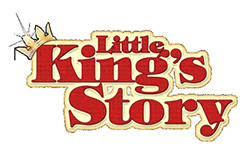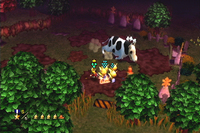|
|

|
PLATFORM
|
Wii
|
BATTLE SYSTEM
|

|
INTERACTION
|

|
ORIGINALITY
|

|
STORY
|

|
MUSIC & SOUND
|

|
VISUALS
|

|
CHALLENGE
|
Moderate
|
COMPLETION TIME
|
20-40 Hours
|
|
OVERALL

|
+ Plays like an addictive simulation
+ Excellent presentation
+ Introduction of mechanics is well-paced
+ Strange sense of humor is hilarious
+ Optional quests encourage exploration
- Some king fights are long and frustrating
|
Click here for scoring definitions
|
|
|
After a pack of rats leads the little boy Corobo to a magical crown, random adults feel compelled to obey his every command, declaring him king of Alpoko and providing him with a rundown shed from which to rule the land. Not content to sit on his throne and stare blankly at the rotting woodwork, Corobo sets out to expand his kingdom by grabbing a slew of sacrificial followers and having them uproot, chop, and slaughter their way across the land in search of money, happiness, and, of course, world domination. The resulting gameplay experience is something between Overlord, Pikmin, and Harvest Moon, but however it is categorized, Little King's Story is one of the best games on the Wii.
At first, the kingdom consists of nothing but carefree adults who lazily sleep or twirl around in circles all day. With their meager assistance, enough money can be gathered to expand the kingdom slightly and convert villagers into farmers and soldiers. Soon thereafter, the game's first guardian monster appears. Once a guardian is defeated, enemies no longer stroll around the field outside the tiny kingdom, and the area can be developed. This forms the basic progression of the game — explore to gain money, use the money to construct buildings that improve the king's Royal Guard, then defeat a guardian to expand. It has the same addictive quality as a good simulation once the world opens up since there are no natural stopping places. Multiple tasks can be completed at any given time, and the player is driven to keep exploring, exterminating, and expanding.
While the setup is similar to a simulation, the battle system itself is akin to an action RPG. The fragile king is nearly worthless in a fight, so he relies on his minions for assistance. Following in a tight formation behind the king, the members of the Royal Guard can be sent careening out in a straight line with the press of a button. Cast people into an enemy, and they will start attacking it. Fling them at a hole in the ground and watch them dig for treasure. Order them to charge a tree, and watch them run into the tree and fall on their rumps. Monsters show a sign when they are about to counterattack, and another press of a button recalls the Royal Guard into formation behind the king. Combat consists of sending out minions, recalling them before a counterattack, and repeating as necessary. Should a follower die, chances are that he will wash ashore at Resurrection Beach the next day without a scratch. Every now and then a character will die permanently, but it happens infrequently enough that the player can be a touch reckless in battle without feeling guilty for letting the villagers, all of which are named, get bumped off.
Different jobs have different strengths and even some weaknesses, so it is important to watch what class is next in line. Soldiers know only how to destroy things, so commanding one to help an engineer build a bridge will result in a quickly thwarted construction attempt. Furthermore, there are jobs in the game which are absolutely necessary in certain situations. Only farmers can uncover health-restoring hot springs. Chefs can cook up a chicken-monster in one hit where even a cadre of fighters would normally struggle. This adds a bit of strategy to the game, but also requires attention to properly utilize. If a child is in the Royal Guard for its tree-climbing skills, accidentally ordering it to attack an enemy is child murder.
 It's good to be the king.
It's good to be the king.
|
|
Fortunately, Little King's Story's controls and interface are up to the task. The nunchuck is used to move the king around the field while the buttons on the remote command the train of villagers. Followers can be sorted and cycled through by job before they are sent charging straight ahead one at a time. The classes of the next five minions in line are clearly displayed on the HUD for quick reference, and the HP of the first few Royal Guard members is displayed above their heads. Like Mario in Super Mario Galaxy, Corobo can only move in eight directions via the analog stick. This is fine for controlling him, but he needs to be directly facing an object for his underlings to correctly interact with it; if he is not lined up perfectly, rather than charging a monster, a helper might sprint right past it and into the face of a cliff. A "line of sight" option is available that both clearly shows what Corobo is facing and locks onto moving monsters. Even with this active, it can take several taps of the stick to lock on to the desired target. It is more a minor exercise in patience than a glaring flaw, though, since the game overall has a slow pace for an action RPG.
A more significant exercise in patience is the boss fights. To take over the world, King Corobo must conquer all of the other kings. While a couple of these fights are typical boss encounters — bigger, cooler monsters who deal more damage and have more HP — some of them go a creative route and play out like a game within a game. One tests the player's knowledge of geography and world trivia. Another boss fight is a pinball game. Another is a series of riddles and memory tests. In concept, they are all fantastic and a welcome change of pace. In execution, they all suffer from the same major flaws: the instructions on how to "play" them are vague, they are way too slowly paced, and they are filled with unskippable dialogue sequences. Depending on how quickly the game within a game is figured out, many of the king fights can take over an hour through repeated attempts, and it is probable that some gamers will need over two hours for a couple of the fights. With enough patience, it is not a big deal, but an impatient person will be furious. This is the only serious flaw in an otherwise well-executed game.
 That's an undead, headless cow guardian.
That's an undead, headless cow guardian.
|
|
The highlight of the game's execution is the marvelous presentation. Little King's Story looks and sounds so excellent, one might think it was crafted by Nintendo rather than a small third party developer. Cutscenes are animated with a gorgeous technique, stylized to look like moving paintings from an illustrated children's book. The soundtrack features prominent, reorchestrated classical music such as Pomp and Circumstance and Rhapsody in Blue. Truly, it is a relief to see a video game that is not afraid to utilize centuries' worth of beautiful, diverse, classical music rather than having a modern composer write similar, inferior scores for a game. Plus, when a gamer's immediate association with the William Tell overture is a certain scene in A Clockwork Orange, it gives guardian fights an unusual connotation.
The strength of the presentation goes beyond music and visuals, though, as the script and story have a consistently amusing vibe. The barrage of jokes and strange humor in Little King's Story is such that a child would giggle at it, but an adult would let out a belly-shaking laugh. There are so many obscure references and almost-said vulgarities that even a well-versed gamer could be left feeling that the true intent of some lines went over his head. Aside from humor that uses words, the game world itself is bizarre and funny, as though Roald Dahl wrote a book titled Charlie and the Farm Factory complete with exaggerated examples of how vices and obsessions can be harmful. From the vicious vegetables — playing this game will forever alter how one views turnips — to the way cows work their way into the most uncowlike places, the setting is Harvest Moon turned upside-down. Even the voice-acting in the game is an entertaining hybrid of gibberish and real words, although the real words are rarely in English. In order to fully appreciate the work that went into the voice-acting, one needs some knowledge of several languages.
The highest compliment for Little King's Story is that it feels like a first party game. From the presentation to the humor to the gameplay's overall addictiveness, the developers and XSEED out-Nintendoed Nintendo in every way. The localization is spot-on. The humor is wonderfully silly in unique ways. It looks better than most Nintendo-published games. It could be the best-sounding game on the Wii. The story is light, but what is there is very creative, hilarious, and worth the player's attention. Aside from some overly difficult guardians and the absurdly drawn-out boss fights, Little King's Story is paced perfectly with an open world that keeps the player busy with optional collection quests and mini-boss fights in addition to the main tasks. This is the first RPG in a long time that all Wii owners simply must play.
Review Archives
|









